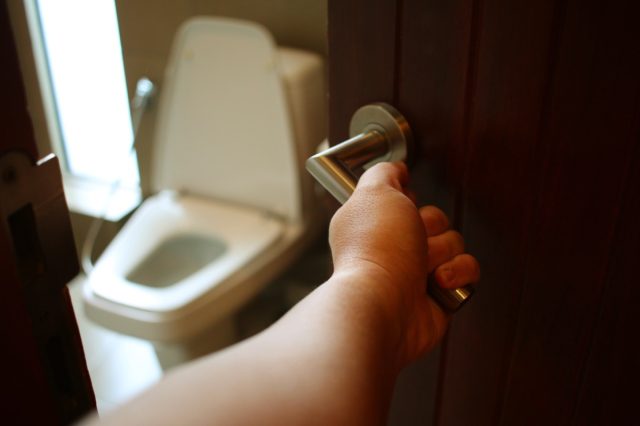These are ‘What To Look For In Your Own Body To See If You Might Have Bladder Cancer, Including Blood Clots’ Although many cases of cancers are much more treatable now, it’s still the second leading cause of death in the United States, behind heart disease. There are over 100 different types of cancer and every year an estimated 81,000 people are diagnosed with bladder cancer. According to the American Cancer Society, “About 81,180 new cases of bladder cancer (about 61,700 in men and 19,480 in women) About 17,100 deaths from bladder cancer (about 12,120 in men and 4,980 in women). The rates of new bladder cancers and deaths linked to bladder cancer have been dropping slightly in women in recent years. In men, incidence rates have been decreasing, but death rates have been stable.”
Bladder cancer can affect anyone, but typically people over the age of 50 are at the greatest risk. The ACS says, “About 9 out of 10 people with this cancer are over the age of 55. The average age of people when they are diagnosed is 73. Overall, the chance men will develop this cancer during their life is about 1 in 27. For women, the chance is about 1 in 89.” However, race can also play a factor. “Whites are more likely to be diagnosed with bladder cancer than African Americans or Hispanic Americans,” the ACS states.
What To Look For In Your Own Body To See If You Might Have Bladder Cancer, Including Blood Clots
While there are no screening tests for bladder cancer, it can be detected early because of visible warning signs that usually cause a person to see a healthcare provider. Knowing the symptoms can be lifesaving and Eat This, Not That! Health spoke with experts who explain what to know about bladder cancer and the signs to look out for. As always, please consult with your physician for medical advice.
READ ARTICLE: Virus Experts Issue New Guidance as RSV, COVID, and Flu Cases Rise

Ronald Tang, DO Board certified Hematologist/Oncologist Los Angeles Cancer Network Beverly Hospital and Los Angeles Cancer Network tells us, “Bladder cancer is not a very common cancer as it only accounts for 4% of all cancer that is diagnosed each year however it accounts for 3% of cancer deaths annually. It is the sixth most common cancer in the US. Men are four times more prone to get this cancer than women. The average age of diagnosis of a bladder cancer patient is over the age of 55. The good thing about bladder cancer is that if detected early it can be cured over 70-80% of the time. Risk factors for bladder cancer include smoking, ingestion of arsenic and exposure to aromatic amines which can be found in some hair dyes and textile work.”
Dr. Sidney Stoll, Medical Director of the Dorothy Leavy Cancer Center at Dignity Health Northridge Hospital says, “People should know that bladder cancer is the most common malignancy involving the urinary system. Transitional cell carcinoma is the predominant form found in the United States and Europe, accounting for about 90% of cases. The spectrum of bladder cancer includes superficial disease, muscle invasive disease, and metastatic bladder cancer. Each type has its own clinical behaviour, biology, prognosis, and treatment.”

Dr. Tang explains, “The most common sign of bladder cancer is hematuria (blood in the urine). This can be detected by the naked eye or can be found on a urinalysis at the doctor’s office. Other warning signs include frequent urinary tract infections or burning upon urination. Unintentional weight loss, fatigue or loss of appetite can be associated with bladder cancer.”
According to Dr. Stoll, “Warning signs of bladder cancer to look out for include painless hematuria (blood in the urine), pain, voiding problems, fatigue, weight loss, and failure to thrive if the malignancy is already advanced.”
John Hopkins Medicine states, “The following irritative urination symptoms are also associated with bladder cancer, though it’s important to know that these also can be present in a variety of benign urologic conditions, like a urinary tract infection or benign prostatic hyperplasia:
- Pain
- Burning
- Frequent urination
- Incomplete emptying of the bladder
- Passage of tissue fragments in urine (less frequent than other symptoms)
The presence of one or all of these signs does not mean you have cancer, but you should be seen by a physician, as these are abnormal bodily functions. Sometimes those diagnosed with bladder cancer do not experience any bleeding or pain. That’s why routine screening and physicals are very important.”

Dr. Tang says, “There is no official screening for bladder cancer but it is usually discovered on a urinalysis that is done at the doctor’s office that may show microscopic blood in the urine. If there is blood found in the urine, then it can be investigated with a cystoscopy which is a procedure that entails a small camera inserted into the bladder and usually done by the urologist.”
Dr. Stoll explains, “The best way to diagnose bladder cancer is through a procedure called a cystoscopy. This is primarily performed in a urologist’s office. It is often combined with urine cytology where cancer cells in the urine may be discovered. Imaging is usually needed including either a CT scan, ultrasound, MRI, or IV pyelogram. A TURBT (transurethral resection of the bladder tumour) is needed for diagnosis and staging purposes. This would also give us an idea of how to treat bladder cancer.”

According to Dr. Tang, “Early-stage bladder cancer is highly treatable with surgery or radiation and cure rates for stage I and II bladder cancer are 88% and 63% respectively. For bladder cancer to be treated effectively, it has to be detected before cancer invades the muscle of the bladder. Once cancer has invaded the muscle of the bladder, cancer can spread or metastasize to other organs which deem the disease incurable. Surgery or chemotherapy that is injected into the surface of the bladder is the mainstay of early-stage bladder cancer. In advanced stages, chemotherapy along with immunotherapy and radiation can be used to treat cancer effectively.”
Dr. Stoll emphasizes, “Bladder cancer is absolutely treatable. The type and complexity of the treatment depend on the stage and aggressiveness of the malignancy. For example, the non-muscle invasive disease may only require TURBT (transurethral resection of the bladder tumour) and intravesical therapy. Weekly intravesical therapy for up to 6 weeks is indicated in patients who have intermediate and high-risk non-muscle invasive disease. On the other hand, muscle-invasive disease treatment is more challenging and complex as usually neoadjuvant chemotherapy is required followed by a cystectomy ( resection of the bladder). If people with the muscle-invasive disease do not want a cystectomy or want to preserve part of their bladder, then concurrent chemotherapy and radiation could be an option for those folks. Finally, metastatic bladder cancer is usually not curable but treatable with either chemotherapy or immunotherapy.”

Dr. Tang explains, “Preventative measures to lower the risk of bladder cancer include cessation of tobacco use, avoidance of certain chemicals in the workplace which include aromatic amines, and adequate hydration which can prevent urinary tract infections.”
Dr. Stoll tells us, “In my opinion living a healthy lifestyle is probably the best way to avoid bladder cancer. One example of living a healthy lifestyle would be the avoidance of smoking cigarettes or smoking cessation. The avoidance of other carcinogens is also important. The avoidance of recurrent urinary tract infections may also lower that risk. Adequate hydration may help in this situation. Bladder cancer appears to be on the rise. One important way to lower one’s risk is tobacco cessation. Don’t be shy to follow up with your PCP or local oncologist if you have questions regarding bladder cancer and how to best approach it if diagnosed. It is a treatable disease and can be cured in many cases if caught early enough.”
READ POST: The 5 Lowest Ranking Diets of 2023

